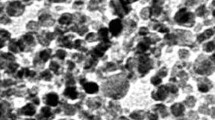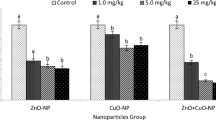Abstract
This research was carried out to evaluate toxic effects of nanosilver (Ag-NPs) on liver function and some blood parameters of male and female mice Mus musculus. A group of 54 BALB/c mice was randomly divided into three groups (each with two replications): Ag-NP (2) and control (1), each with nine mice. The experiment lasted for 14 days. In the treatment groups, two different doses of 20 and 50 ppm of Ag-NP solution were administered orally, while in the untreated (control) group, no Ag-NP solution but distilled water was used. At the end of the experiment, the serum was obtained by centrifugation of the whole blood at 3000 rpm for 15 min. The biochemical levels including alanine aminotransferase (ALT), aspartate amino transferase (AST), and blood cells were assayed by an automatic biochemical analyzer. Also, liver biopsy was performed and samples were stained using hematoxylin and eosin (H&E) staining. The values of red blood cells (RBC), hemoglobin (Hb), and hematocrit (Hct) did not vary significantly in the control and Ag-NP-treated animals. There were significant changes in the treatment and control groups in the levels of liver enzymes so that at both doses, there were significantly elevated levels of ALT and AST in mice treated with Ag-NPs compared with the control (p < 0.05). Sexuality was not significantly involved in the results. Oral exposure to Ag-NPs produced changes in blood chemistry and hepatotoxicity as indicated by increased serum activity levels of both AST and ALT and histological damages to the liver with no significant changes between male and female mice.









Similar content being viewed by others
References
The impact of silver nano particles on growth performance, lymphoid organs and oxidative stress indicators in broiler chicks. Global Veterinaria, 5: 366-370
Sawosza E, Bineka M, Grodzika M, Zieliñskaa M, Sysaa P, Szmidt M, Niemiec T, Chwalibog A (2007) Influence of hydrocolloidal silver nanoparticles on gastrointestinal microflora and morphology of enterocytes of quails. Arch Anim Nutr 61(6):444–451
Karimi M, Jeddi AND, Ahmadi F (2008) Evaluation of the effectiveness of different levels of silver nanoparticles on bursa of Fabricius development and on its histopathological lesions in broiler chicks. Acta Agraria Kaposvariensis 3(2):353–360
Mritunjai S, Singh S (2008) Nanotechnology in medicine and antibacterial effect of silver nano particles. J Nanomaterials Biostructures 3(3):115–122
Lara HH, Garza-Treviño EN, Ixtepan-Turrent L, Singh DK (2011) Silver nanoparticles are broad-spectrum bactericidal and virucidal compounds. J Nanobiotechnology. 3;9:30
Park EJ, Bae E, Yi J, Kim Y, Choi K (2011) Repeated-dose toxicity and inflammatory responses in mice by oral administration of silver nanoparticles. Environ Toxicol Pharmacol 30:162–168
Kim S, Choi JE, Choi J, Chung K-H (2009) Oxidative stress-dependent toxicity of silver nanoparticles in human hepatoma cells. Toxicol in Vitro 23:1076–1084
Takenaka S, Karg E, Roth C, Schulz H, Ziesenis A, Heinzmann U, Schramel P, Heyder J (2001) Pulmonary and systemic distribution of inhaled ultrafine silver particles in rats. Environ Health Perspect 4:547–551
Cheraghi J, Hosseini E, Hoshmandfar R (2013) In vivo effect of silver nanoparticles on serum ALT, AST and ALP activity in male and female mice. Adv Environ Biol 7(1):116–122
Woodrow Wilson International Center (2010) The Project on Emerging Nanotechnologies. Washington, USA. Available at: http://www.nanotechproject.org/inventories/consumer/analysis draft (accessed 23.06.10)
Farkas J, Christian P, Peter H, Roos N, Urrea JAG, Hassellِ VM, Tollefsen KE, Thomas KV, Hylland K (2011) Initial assessment of silver nanoparticles from washing machines. Environ Int 37(6):1057–1062
Griffitt RJ, Hyndman K, Denslow ND, Barber DS (2009) Comparison of molecular and histological changes in zebrafish gills exposed to metallic nanoparticles. Toxicol Sci 107(2):404–415
Chang AL, Khosravi V, Egbert B (2006) A case of argyria after colloidal silver ingestion. J Cutan Pathol 33:809–811
Gatti AM, Montanari S, Monari E, Gambarelli A, Capitani F, Parisini B (2004) Detection of micro- and nano-sized biocompatible particles in the blood. J Mater Sci Mater Med 15:469–472
Tang J, Xiong L, Wang S (2009) Distribution, translocation and accumulation of silver nanoparticles in rats. J Nanosci Nanotechnol 9(8):4924–4932
Aniya Y, Koyama T, Miyagi C, Miyahira M, Inomata C, Kinoshita S, Ichiba T (2005) Free radical scavenging and hepatoprotective actions of the medicinal herb, Crassocephalum crepidioides from the Okinawa Islands. Biol Pharm Bull 28(1):19–23
Martínez-Gutierrez F, Thi EP, Silverman JM, de Oliveira CC, Svensson SL, Vanden HA et al (2012) Antibacterial activity, inflammatory response, coagulation and cytotoxicity effects of silver nanoparticles. Nanomed 8(3):328–36
Lee TY, Liu MS, Huang LJ, Lue SI, Lin LC et al (2013) Bioenergetic failure correlates with autophagy and apoptosis in rat liver following silver nanoparticle intraperitoneal administration. Particle Fib Toxicol 10(40):1–13
Kvitek L, Vanickova M, Panacek A et al (2009) Initial Study on the Toxicity of Silver Nanoparticles (NPs) against Paramecium caudatum. J Phys Chem C 113(4296–4300):2009
Greulich C, Braun D, Peetsch A, Diendorf J et al (2012) The toxic effect of silver ions and silver nanoparticles towards bacteria and human cells occurs in the same concentration range. RSC Adv 2:6981–6987
Acknowledgments
While thanking Shahrekord University, the authors thank Mr Hatamei, Veterinary Section of Shahrekord University, for his technical assistance and Dr. Fattahian, a member of academic staff of Shahrekord University, for his sincere help in tissue identification and pathology.
Conflict of interests
The authors declare that they have no competing interests.
Authors’ contributions
MSH carried out the preliminary studies, established the methods, and drafted the manuscript. He performed experiments and drafted the manuscript. RJS and SA collected data, performed experiments, and provided substantial input in data interpretation and analysis. All authors gave final approval to the version to be published.
Author information
Authors and Affiliations
Corresponding author
Rights and permissions
About this article
Cite this article
Heydrnejad, M.S., Samani, R.J. & Aghaeivanda, S. Toxic Effects of Silver Nanoparticles on Liver and Some Hematological Parameters in Male and Female Mice (Mus musculus). Biol Trace Elem Res 165, 153–158 (2015). https://doi.org/10.1007/s12011-015-0247-1
Received:
Accepted:
Published:
Issue Date:
DOI: https://doi.org/10.1007/s12011-015-0247-1




